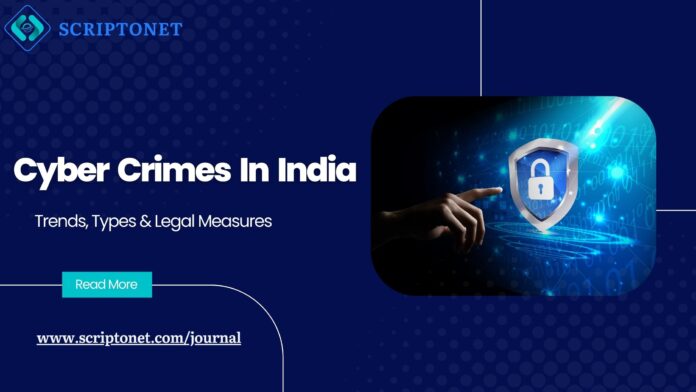Introduction
Cyber crimes in India refers to any illegal activity that involves a computer, network or internet-connected device. It encompasses a wide range of offenses carried out in the digital realm. The rapid growth of digital transactions, the widespread use of social media platforms & the increasing reliance on online services in India have unfortunately been accompanied by a parallel surge in cybercrime. This rise can be attributed to increased accessibility & connectivity, coupled with the anonymity & borderless nature of the internet, which makes it an attractive avenue for malicious actors.
Several types of cybercrimes are prevalent in India. These include, but are not limited to, hacking, phishing, identity theft, cyberbullying & various forms of financial fraud. The impact of cybercrime on Indian society is significant & far-reaching. Individuals can suffer financial losses, emotional distress & reputational damage. Businesses face the risk of data breaches, financial losses & disruption of operations.
At a national level, cybercrime can threaten critical infrastructure, national security & the overall economy. Therefore, robust cybersecurity measures are essential to combat this growing threat. This includes the development & enforcement of effective cyber laws, raising awareness among citizens about online safety practices & implementing preventive measures at individual, organisational & national levels to mitigate the risks associated with cybercrime in India.
Types of Cyber Crimes in India
India is witnessing a surge in cybercrime, with various types of offenses being reported. Here’s a look at some of the most prevalent cybercrimes in India, along with relevant statistics:
Financial Frauds
Online Scams: These include phishing, lottery scams, fake job offers & fraudulent investment schemes.
Credit/Debit Card Fraud: Unauthorized use of card details for online transactions or ATM withdrawals.
UPI Fraud: Scams involving Unified Payments Interface (UPI) apps, such as fake payment requests & QR code manipulation.
Statistics: Cyber frauds jumped by a staggering 900% in the last four (4) years, with small cities like Deoghar, Nuh & Mathura emerging as new scam hotspots. Fraudsters cheated people out of ₹33,165 crore in the last four (4) years, including ₹22,812 crore in 2024 alone.
Hacking
Website Defacement: Unauthorized access to websites & altering their content.
Data Breaches: Stealing sensitive data from individuals or organizations.
Denial-of-Service (DoS) Attacks: Overwhelming a website or network with traffic, making it inaccessible to users.
Statistics: In 2023, India saw 129 cybercrimes per lakh population. Delhi led with the highest rate of 755, followed by Haryana (381) & Telangana (261).
Phishing
Email Phishing: Deceptive emails pretending to be from legitimate organizations to trick recipients into revealing personal information.
SMS Phishing (Smishing): Similar scams conducted through text messages.
Statistics: Phishing remains one of the most common forms of cybercrime globally, with a significant number of incidents reported in India as well.
Identity Theft
Stealing personal information such as Aadhaar numbers, PAN details & bank account information for fraudulent purposes.
It can lead to financial losses, damage to credit scores & other serious consequences for the victim.
Cyberbullying:
Harassment, intimidation or threats through social media, messaging apps or online gaming platforms.
It can have severe emotional & psychological impacts on victims, especially children & adolescents.
Cyberstalking
Repeated harassment or intimidation through electronic communication, causing fear or distress to the victim.
Sextortion
Using threats or coercion to obtain sexual favors or images from a victim online.
Online Grooming
Building relationships with minors online for sexual exploitation.
Ransomware Attacks
Malicious software that encrypts a victim’s data & demands a ransom for its release.
Cryptocurrency Scams
Fraudulent schemes involving cryptocurrencies, such as fake investment opportunities or Ponzi schemes.
Legal framework for Cyber Crimes in India
India has a comprehensive legal framework to address cyber crimes, primarily based on the following legislation.
The Information Technology Act, 2000, is the primary legislation dealing with cybercrime, cybersecurity & data protection in India. It provides legal recognition to electronic transactions & communications. It defines various cyber offenses & prescribes penalties for them.
Some provisions include Section 43 (penalty for unauthorized access to a computer system), Section 65 (punishment for tampering with computer source documents), Section 66 (punishment for hacking), Section 66B (punishment for dishonestly receiving stolen computer resources or communication devices), Section 66C (punishment for using the password of another person), Section 66D (punishment for cheating by personation using computer resources), Section 67 (punishment for publishing or transmitting pornographic material in electronic form), Section 66E (punishment for privacy violation), Section 66F (punishment for cyberterrorism), and Section 67A (punishment for publishing or transmitting material containing sexually explicit acts, etc. in electronic form).
The Indian Penal Code, 1860, while the IT Act is the primary law for cybercrimes, also covers certain offenses that can be committed in cyberspace. These include cheating (Section 420), fraud (Section 415), forgery (Section 463), criminal intimidation (Section 506) & defamation (Section 499).
Other relevant laws include The Digital Personal Data Protection Act, 2023 that focuses on the protection of digital personal data & imposes obligations on data fiduciaries, The Intermediary Guidelines and Digital Media Ethics CodeRules, 2021 that lays down guidelines for intermediaries, including social media platforms, to ensure online safety & tackle misinformation & RBI Guidelines the Reserve Bank of India has issued various guidelines on cybersecurity for banks & financial institutions.
Challenges & future directions include enforcement that is effective enforcement of cyber laws remains a challenge due to the evolving nature of cybercrime & the lack of specialized cybercrime cells in all police stations, international cooperation because cyber crimes often have international dimensions, requiring cooperation with other countries for investigation & prosecution, awareness because lack of awareness among citizens about cyber threats & online safety practices makes them vulnerable to cyber crimes & capacity building as here is a need for continuous training & capacity building for law enforcement agencies, judges & other stakeholders to effectively deal with cybercrimes.
Preventive methods & Cyber Security initiatives
Combating cybercrime requires a multi-pronged approach encompassing preventive measures at individual & organizational levels, along with robust national cybersecurity initiatives.
Individual Level Preventive Measures
Strong Passwords & Multi-Factor Authentication (MFA): Using complex & unique passwords for each account & enabling MFA wherever possible significantly reduces the risk of unauthorized access.
Software Updates: Regularly update operating systems, applications & antivirus software patches security vulnerabilities.
Caution with Links & Attachments: Being wary of clicking on suspicious links or opening attachments from unknown senders helps prevent phishing & malware infections.
Secure Browsing Habits: Avoiding visiting untrusted websites & being cautious about sharing personal information online minimizes the risk of data breaches.
Privacy Settings: Configuring privacy settings on social media & other online platforms limits the amount of personal information exposed.
Awareness & Education: Staying informed about common cyber threats & best practices for online safety is crucial.
Organizational Level Preventive Measures
Cybersecurity Policies & Procedures: Implementing comprehensive cybersecurity policies & procedures helps establish a strong security posture.
Firewalls & Intrusion Detection Systems: Deploying Firewalls & Intrusion Detection Systems helps protect networks from unauthorized access & malicious activity.
Data Encryption: Encrypting sensitive data both in transit & at rest ensures that even if a breach occurs, the data remains unreadable.
Regular Security Audits & Vulnerability Assessments: Conducting regular security audits & vulnerability assessments helps identify & address weaknesses in the system.
Employee Training: Training employees about cybersecurity best practices & how to recognize & respond to cyber threats is essential.
Incident Response Plan: Having a well-defined incident response plan in place enables organizations to effectively manage & mitigate cyberattacks.
National Cybersecurity Initiatives
National Cyber Security Policy: India’s National Cyber Security Policy provides a framework for protecting critical infrastructure & combating cybercrime.
CERT-In: The Indian Computer Emergency Response Team (CERT-In) is a national agency responsible for responding to cyber incidents & providing cybersecurity advisories.
National Critical Information Infrastructure Protection Centre (NCIIPC): The NCIIPC is responsible for protecting critical information infrastructure from cyber threats.
Conclusion
Cybercrime in India is a complex & evolving issue. While India has made significant strides in establishing a legal framework to combat cybercrime, challenges remain in terms of enforcement, awareness & keeping pace with technological advancements. The rise in cybercrime can be attributed to factors such as increased internet penetration, rapid digitalization & a lack of awareness among users. To effectively address cybercrime in India, a multi-faceted approach is needed.
This multi-faceted approach includes strengthening cybersecurity infrastructure, which involves building robust systems & protocols to protect against cyber threats; raising awareness by educating individuals & organizations about cyber risks & best practices; enhancing law enforcement capabilities by equipping law enforcement agencies with the necessary skills & resources to investigate & prosecute cybercrimes; fostering collaboration between government, industry & international partners for sharing information & best practices & updating legal frameworks to continuously address emerging cyber threats. By taking these steps, India can create a safer cyberspace for its citizens & businesses.
Frequently Asked Questions (FAQ)
Which categories of cybercrimes are most prevalent in India?
Common examples of cybercrimes include phishing, online fraud, hacking, identity theft & cyberstalking.
How can I protect myself from cybercrime?
The answers typically involve strong passwords, being cautious of suspicious links, using antivirus software & keeping software updated.


